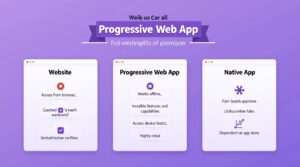click to get service View profile
Introduction
While UX Design for Digital Marketing focuses on optimizing user experiences, marketing aims to build brand awareness and drive conversions. Many assume these two fields are entirely separate, with no common ground. As a result, the role of UX experts in marketing campaigns is often overlooked, and UX designers are rarely included in marketing teams.
However, a 2016 Forrester report revealed that a well-crafted UX Design for Digital Marketing can boost conversion rates by 400% in marketing campaigns. This highlights the immense impact of user experience in driving engagement, improving customer journeys, and maximizing marketing success.
So, where do UX Design for Digital Marketing and marketing intersect? And how do UX experts enhance marketing effectiveness? Let’s explore these insights in this article!
Where do UX Design and Digital Marketing Collide?
UX Design for Digital Marketing refers to the impressions, emotions, and experiences users have while interacting with digital marketing touchpoints such as mobile applications, landing pages, and content. A seamless and intuitive UX enhances engagement, builds trust, and ultimately drives higher conversions.
Some aspects that UX Designers can improve during a Digital Marketing campaign include:
- Buying process
- Website information accessibility
- Ease of access
- Load speeds
- Advertisement placements
- Brand voice and tone
Jared Spool, in his interview with Martech, highlighted that UX Design for Digital Marketing is the most crucial driver of all marketing metrics. Optimizing UX design not only enhances the experience of potential customers but also fuels word-of-mouth marketing. When users have positive experiences, they are more likely to share their satisfaction and recommend your products or services to others, amplifying your brand’s reach and credibility.
5 ways that UX design improves the effectiveness of digital marketing.
1. Optimize customer experience

A well-crafted UX Design for Digital Marketing plays a vital role in building strong customer relationships. It ensures that users feel valued and that a marketing campaign respects their time. McKinsey highlighted that optimizing customer journeys can increase customer satisfaction by 20% and boost business revenue by 15%. Additionally, when customers have a seamless and enjoyable experience, they are more likely to develop brand loyalty, leading to long-term business growth. Check this out!
Check this out: How does UX audit contribute to higher sales in the online marketplace?
2. Improve SEO quality
Any marketer can leverage SEO tools to identify keywords and integrate them into digital content. However, UX Design for Digital Marketing plays a crucial role in enhancing search visibility. A well-optimized UX ensures that visitors stay longer on your website, reducing bounce rates and increasing engagement.
Beyond bounce rates, pogo-sticking is another critical factor that Google considers when ranking content. Pogo-sticking happens when users rapidly navigate back and forth between search results, indicating that they are not finding relevant or valuable content.
Websites with high pogo-sticking or bounce rates often experience lower rankings on Google Search, as the algorithm prioritizes pages that provide a seamless and engaging user experience. This reinforces the importance of UX Design for Digital Marketing in improving search visibility and retaining visitors.
This underscores the unparalleled importance of UX Design for Digital Marketing in SEO rankings. An intuitive and engaging user experience not only enhances search performance but also strengthens overall digital marketing success by keeping visitors engaged and reducing bounce rates.
3. Optimize mobile experience

Statista reported that nearly 60% of website traffic in 2022 came from mobile devices, with over 60% of users preferring to purchase from mobile-friendly websites. Additionally, Experience Dynamics found that mobile users are 5 times more likely to abandon a task if the website isn’t optimized for mobile.
This reinforces the crucial role of UX Design for Digital Marketing in ensuring a seamless mobile experience, improving engagement, and maximizing conversions.
Given these statistics, the importance of optimizing mobile experience is undeniable. UX Design for Digital Marketing plays a key role in ensuring seamless mobile usability, helping businesses retain conversion rates and improve SEO rankings. By prioritizing mobile-friendly UX, companies can enhance engagement, reduce drop-offs, and drive more successful marketing outcomes.
4. Reduce cost
Digital marketers invest heavily in Pay-Per-Click (PPC) and Google AdWords to drive traffic and increase conversions. However, without a well-optimized UX Design for Digital Marketing, visitors may struggle to find what they need, leading to frustration and wasted marketing investment. A seamless user experience ensures that traffic converts into meaningful engagement and higher sales.
According to McKinsey, optimizing customer journeys can reduce customer service costs by up to 20%. Conversely, a poor UX Design for Digital Marketing negatively impacts search engine visibility. If Google detects high pogo-sticking—where users quickly return to search results—it signals a bad experience, lowering your ranking for important keywords.
When this happens, your chances of appearing on the first search page drop significantly, making your organic traffic efforts ineffective. This emphasizes the need for a seamless UX Design for Digital Marketing to enhance user engagement, reduce bounce rates, and maximize the success of both paid and organic marketing strategies.
5. Build conversions

Attracting potential customers to your marketing efforts is a great start, but converting them into subscribers, members, or buyers is a different challenge. According to a Design Management Institution report, design-led companies have outperformed the Standard and Poor index by 228% in retaining their stock market advantage over the past decade.
A well-optimized UX Design for Digital Marketing effectively guides users through each stage of the buying process, increasing conversion rates. Additionally, UX helps create conversion funnels that identify and eliminate obstacles in the user journey, allowing marketers to refine their strategies and enhance the overall experience.
Learn more: Top 5 UX Metrics Frameworks to measure your design performance
Conclusion
Given the immense value of UX Design for Digital Marketing, fit’s essential to make it a core part of your digital marketing strategy. By doing so, you can enhance campaign performance, improve user engagement, and drive higher conversion rates.
However, as Martech’s experts point out, there are no definitive KPIs or analytics indicators that directly measure the impact of UX Design for Digital Marketing on campaign performance. The best approach is to integrate UX principles into your marketing strategies and compare the results with previous campaigns that lacked UX optimization. This allows businesses to assess the true value of UX in enhancing engagement, conversions, and overall marketing success.
If you’re looking for a team of experts passionate about crafting exceptional UX Design for Digital Marketing that aligns with your business goals, look no further! Contact us today to discover how we can enhance your design strategy, improve user engagement, and drive marketing success.

